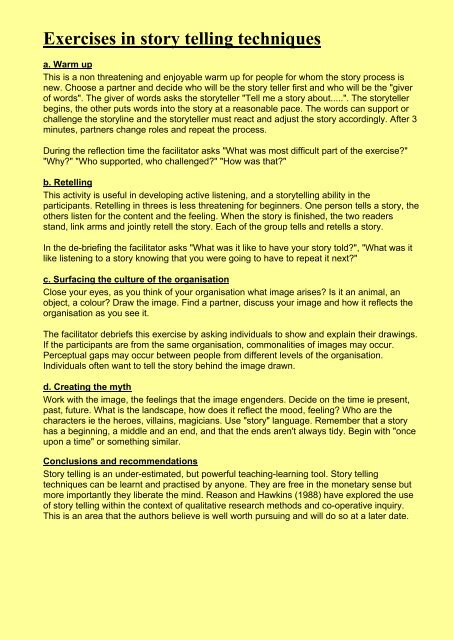HOW TO WRITE BETTER FAIRY TALES - DEAN AMORY
Complete course on writing Fairy Tales (aka Wonder Tales)
Complete course on writing Fairy Tales (aka Wonder Tales)
Create successful ePaper yourself
Turn your PDF publications into a flip-book with our unique Google optimized e-Paper software.
Exercises in story telling techniques<br />
a. Warm up<br />
This is a non threatening and enjoyable warm up for people for whom the story process is<br />
new. Choose a partner and decide who will be the story teller first and who will be the "giver<br />
of words". The giver of words asks the storyteller "Tell me a story about.....". The storyteller<br />
begins, the other puts words into the story at a reasonable pace. The words can support or<br />
challenge the storyline and the storyteller must react and adjust the story accordingly. After 3<br />
minutes, partners change roles and repeat the process.<br />
During the reflection time the facilitator asks "What was most difficult part of the exercise?"<br />
"Why?" "Who supported, who challenged?" "How was that?"<br />
b. Retelling<br />
This activity is useful in developing active listening, and a storytelling ability in the<br />
participants. Retelling in threes is less threatening for beginners. One person tells a story, the<br />
others listen for the content and the feeling. When the story is finished, the two readers<br />
stand, link arms and jointly retell the story. Each of the group tells and retells a story.<br />
In the de-briefing the facilitator asks "What was it like to have your story told?", "What was it<br />
like listening to a story knowing that you were going to have to repeat it next?"<br />
c. Surfacing the culture of the organisation<br />
Close your eyes, as you think of your organisation what image arises? Is it an animal, an<br />
object, a colour? Draw the image. Find a partner, discuss your image and how it reflects the<br />
organisation as you see it.<br />
The facilitator debriefs this exercise by asking individuals to show and explain their drawings.<br />
If the participants are from the same organisation, commonalities of images may occur.<br />
Perceptual gaps may occur between people from different levels of the organisation.<br />
Individuals often want to tell the story behind the image drawn.<br />
d. Creating the myth<br />
Work with the image, the feelings that the image engenders. Decide on the time ie present,<br />
past, future. What is the landscape, how does it reflect the mood, feeling? Who are the<br />
characters ie the heroes, villains, magicians. Use "story" language. Remember that a story<br />
has a beginning, a middle and an end, and that the ends aren't always tidy. Begin with "once<br />
upon a time" or something similar.<br />
Conclusions and recommendations<br />
Story telling is an under-estimated, but powerful teaching-learning tool. Story telling<br />
techniques can be learnt and practised by anyone. They are free in the monetary sense but<br />
more importantly they liberate the mind. Reason and Hawkins (1988) have explored the use<br />
of story telling within the context of qualitative research methods and co-operative inquiry.<br />
This is an area that the authors believe is well worth pursuing and will do so at a later date.


















